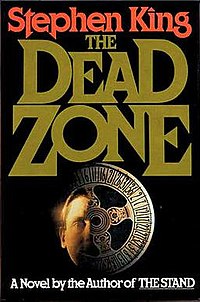The Dead Zone
by Stephen King
As a child in 1953, Johnny Smith falls unconscious while ice-skating, then mumbles a prophetic warning to an adult who later suffers an accident. In an unconnected incident, a young, emotionally troubled door to door Bible salesman named Greg Stillson vindictively kicks a dog to death.
By 1970, Johnny is a high school teacher in Maine with a girlfriend named Sarah. After winning repeatedly at a carnival wheel of fortune, Johnny is involved in a car accident. Upon waking from a four year long coma, Johnny finds that he has suffered neural injury but now has clairvoyant visions after touching people and objects. After helping various people, Johnny becomes frustrated by sensationalistic media reports of his supposed psychic talents. When Johnny rejects a lucrative offer from tabloid reporter Richard Dees to run fake predictions under Johnny's name, Dees' paper maliciously prints a story denouncing Johnny as a fraud. Relieved, Johnny hopes to resume a normal life as a teacher despite severe headaches. Instead, Sheriff George Bannerman asks him to help catch a local serial killer. After a nine-year-old girl is murdered, Johnny reluctantly identifies the killer as Bannerman's deputy Frank Dodd, who commits suicide after leaving a confession. As Johnny feared, the incident reignites the public's interest.
Stillson, now a successful businessman and mayor of Ridgeway, New Hampshire, threatens to kill the people he bullies if they reveal his actions. In 1976, he wins a seat in the U.S. House of Representatives as an independent, having blackmailed a local businessman into raising funds for him. When Johnny proves too controversial to return to teaching, he becomes a private tutor in Ridgeway and develops an interest in politics. He meets Stillson, and is horrified to see a vision of an older Stillson, who is eventually elected President and causes a massive, worldwide nuclear conflict. As Johnny's health worsens, he contemplates how to prevent Stillson's presidency and compares the matter to whether, if time travel were possible, one should kill Hitler in 1932. Eventually, he concludes assassinating Stillson is the only way to be sure the vision does not come true, but he procrastinates. Johnny rationalizes his inaction because of doubt in his vision, abhorrence of murder, and his belief that there is no urgent need to act immediately.
An FBI agent who had been investigating Stillson is killed by a car bomb, and Johnny's warnings fail to save everyone from a disaster at his pupil's graduation party. Now believing that he must take more decisive action to prevent his visions, Johnny buys a rifle and resolves to kill Stillson at his next rally, aided by the grim knowledge that his headaches are the result of a brain tumor. At the rally, Stillson begins his speech. Johnny shoots at Stillson but misses and is wounded by Stillson's bodyguards. Before he can fire again, Stillson grabs a young child and holds him up as a human shield. Johnny pauses, unable to shoot, and is shot twice by the bodyguards, falls off the balcony, and is mortally wounded. A bystander photographs Stillson's act, and, when published, the picture destroys Stillson's political career and his chances of becoming president. Dying, Johnny touches Stillson a final time but feels only dwindling impressions and knows that the terrible future has been prevented.
An epilogue intersperses excerpts of letters from Johnny to his loved ones, a "Q & A" transcript of a purported Senate committee (chaired by real-life Maine Senator William Cohen) investigation of Johnny's attempt to assassinate Stillson, and a narrative of Sarah's visit to Johnny's grave. Sarah feels a brief moment of psychic contact with Johnny's spirit and, comforted, drives away.
